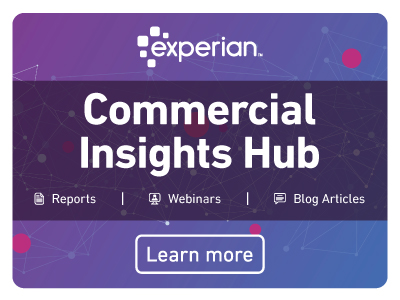All posts by Gary Stockton
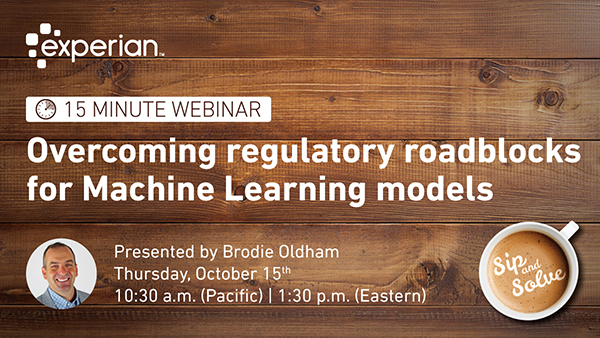
The concept of machine learning has been around for 50+ years in analytic circles. But machine learning methods have created a stir in the last few years as their popularity and visibility increased in the U.S. consumer and commercial credit industry. The use of these advanced methodologies has been constrained to mainly fraud/identity and collections. Machine Learning techniques are now available for credit decisioning. Our upcoming Sip and Solve session will provide insights to help your regulator feel more comfortable with the methodology you are using. We will share how Experian is making machine learning explainable to regulators and boosting model performance. During this session you will learn three take-aways: Current model governance basics How machine learning methods are boosting performance Best practices in deployment and documentation to help regulators feel comfortable with this more powerful solution
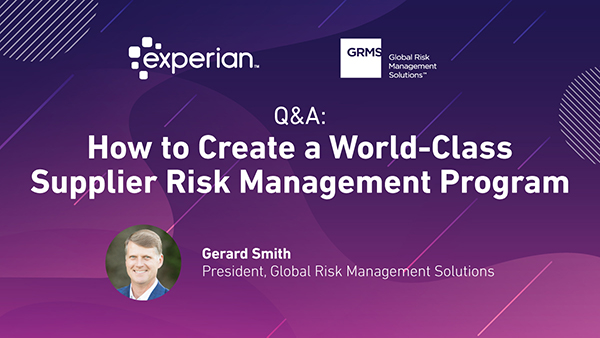
Supplier risk management has become a top priority for procurement and supply chain professionals. With rising regulatory and compliance fines and the global market disruptions caused by trade wars and the pandemic, a robust supplier risk management program is crucial. Gerard Smith, President and Co-founder of Global Risk Management Solutions, shares insights on creating a world-class supplier risk management program. In this interview, discover the essential components and strategies to effectively manage supplier risk and ensure compliance and stability in your supply chain. Evolution of Supplier Risk Management Practices Twenty years ago, when I was in procurement, many organizations self-performed everything. In other words, they collected documents and validated them as best as they could. The issue today is with COVID. With COVID, many companies are concerned. The two things we keep hearing about is the financial stability of the suppliers. Are they financially stable? Not only today, but in the foreseeable future, and secondarily, do they have insurance to protect the client company if there are any errors. So, it's the financials currently, and the insurance companies are most concerned about monitoring. Increasing Complexity in Supplier Risk Management Companies are starting to source globally, and more and more companies are concerned about the supply chain and if there are issues, whether geopolitical or whatever the case may be. So the idea here is to manage supplier risk proactively, and so there are three components of that. First, based on a client's requirements - the ability to do the risk assessment based on specific risk components. Second, having a help desk to try and troubleshoot where there are issues with the suppliers to help them to get into compliance. And third, most importantly, being able to monitor those suppliers for changes in status and getting actual push alerts, to be able to act on those. So, in other words, getting in front of the problem versus finding out that a supplier perhaps filed bankruptcy or showed up on a government watch list or something like that. Key Components of a World-Class Supplier Risk Management Program If a company wishes to have a world-class supplier risk management program, there are five crucial components that you would want to see, they are: Customized Risk Program A Customized Risk Program is tailored to address specific risk components relevant to a company's unique needs. This customization can take various forms: Geographical Considerations: Different regions, such as EMEA (Europe, Middle East, and Africa) and APAC (Asia-Pacific), have distinct regulatory requirements and market conditions. A Customized Risk Program can adapt to these regional differences, ensuring compliance and appropriate risk management practices in each area. Spending Levels: Companies often have both strategic and non-strategic suppliers. Strategic suppliers, with whom the company spends more, may require a more thorough and detailed risk assessment compared to non-strategic suppliers. Customizing the risk program based on spending levels ensures that critical suppliers are monitored more closely. Specific Risk Factors: Different industries and companies face unique risks. Whether it's financial stability, compliance with specific regulations, or reputational risks, a Customized Risk Program can focus on the most relevant risk factors for the company. The key objective of a Customized Risk Program is flexibility. It must be able to adapt to various factors such as geography, spending, and specific risk elements, ensuring it is not a one-size-fits-all solution but rather a bespoke approach to managing supplier risk effectively. Adjudicating Information This involves the critical process of verifying and clarifying data to ensure accuracy. This means systematically identifying and eliminating false positives, which occur when incorrect or irrelevant information is selected. For instance, if you input "Bob's Plumbing" into a database, you might receive numerous results for companies with similar names. The challenge is to determine which "Bob's Plumbing" is the correct one that your company works with. Adjudicating information requires sophisticated methods to accurately select the correct entity and cross-verify the details, ensuring that the data is precise and applicable to your specific supplier. This process is essential for maintaining the integrity and reliability of your supplier risk management program. Reporting In a supplier risk management program, reporting capability is vital for maintaining consistent and measurable compliance standards. This involves generating real-time, standardized reports that provide current risk ratings for all suppliers. With these reports, management can quickly identify which suppliers are in compliance with set standards and which are not, along with the reasons for non-compliance. Additionally, the reports highlight any ongoing issues within the supply chain, enabling management to address problems promptly. Effective reporting ensures transparency, accountability, and the ability to make informed decisions based on up-to-date risk assessments. Document Verification and Monitoring In a supplier risk management program, Document Verification and Monitoring is crucial for ensuring the authenticity and accuracy of the documents submitted by suppliers. While collecting and managing documents can be straightforward, the challenge lies in verifying their validity. Many procure-to-pay, source-to-pay, and ERP platforms face this issue, as they often rely on suppliers to upload documents without proper verification. This can result in the acceptance of invalid or even blank documents. To address this, a robust system or process must be in place to validate key documents such as certificates of insurance, W9 forms, and other critical documentation. This system should not only collect documents but also authenticate them, ensuring they meet the required standards and are current. Continuous monitoring of these documents is essential to maintain compliance and mitigate risks associated with outdated or fraudulent information. By implementing thorough document verification and monitoring, companies can ensure the integrity of their supplier risk management program. Continuous Monitoring Continuous Monitoring refers to the ongoing, real-time oversight of supplier activities and conditions to promptly identify and address potential risks. A primary focus of continuous monitoring is assessing the financial stability of suppliers. This means regularly evaluating their financial health to detect any signs of trouble. If a supplier shows indications of financial distress, such as declining financial metrics or negative market signals, the company can take proactive measures, such as halting purchase orders, to prevent potential disruptions in the supply chain. Continuous monitoring ensures that companies can swiftly respond to changes in a supplier's status, maintaining the reliability and integrity of their supply chain operations. Critical Risk Components for Effective Supplier Risk Management There are eight different risk categories. The risk components that companies should at least address within their program. Financial Stability Financial stability is monitoring financial stability in real-time and be able to identify if there are issues whether they are getting in worse financial shape or perhaps getting in better financial shape. Digital Insurance Verification The best practice right now is what's called digital insurance verification. We're able to manage insurance coverage electronically. We don't even have to collect a certificate of insurance anymore. We can do it digitally in North America. That means that we can monitor a supplier to ensure that they continue to have the insurance requirements daily, which is a unique situation. So you want to make sure, at a minimum, you collect the certificate of insurance. If you want the best practice, you do digital insurance verification. Reputational Protection We do global adverse media monitoring. So as an example, we manage over 25,000 media sources around the globe looking for negative stories because you want to know if your supplier is caught with child labor, or if they've closed a facility somewhere in the world that you're reliant upon. So adverse media is very big at this point because things are evolving very quickly. Regulatory Compliance Regulatory compliance is basically anything that's government regulation. So, it could be the various sanctions lists. Most people don't recognize there are over 1500 watch and sanctions lists around the globe including the U.S OFAC list. That's a big one. It can be a Conflict Minerals Declaration, U.K. Modern Slavery Act, Reach ROHS, the California Transparency Act, anything that's a government regulation falls into that category. Cyber Security Cyber Security would be anything that's involved with data and document verification. It has to be able to collect and validate not only the documents such as a code of conduct, but documents with an expiration date such as an NDA or a diversity certificate. Any standardized documents should be part of the program so suppliers don't get continuously contacted for more documents. Social Responsibility Social responsibility could be anything from diversity verification, child labor, those types of things. Document Management Validate key documents such as certificates of insurance, W9 forms, and other critical documentation. This system should not only collect documents but also authenticate them, ensuring they meet the required standards and are current. Continuous monitoring of these documents is essential to maintain compliance and mitigate risks associated with outdated or fraudulent information. Health and Safety Finally, health and safety could include an HSC questionnaire, EMR ratings, or OSHA statistics. Those are eight areas that companies should at least consider looking into as far as potential risk components. Obviously, there are different parts of each, one of those where those are the broad categories. Global Supplier Risk Assessments: Reliability and Challenges Dependingon what country we're speaking of. Is the information available? Yes, there are varying degrees of information. You can get more information in North American and EMEA than you can say in APAC or South America. Is it available? Absolutely. We can do a supply risk assessment in over 120 countries. So, it is possible to get information. There is standardized information in terms of the adverse media I spoke about. The watch and sanctions list, those are all global. There's a variety of things that can be managed globally. Some of it, in terms of the financial, for instance, it depends on which country we're talking about and how much information can be obtained within that country, and secondarily, whether it can be monitored on an ongoing basis. Again, it depends on which country we're speaking about. In summary Establishing a world-class supplier risk management program involves understanding the evolution of risk management practices, addressing increasing complexities, and incorporating critical components such as financial stability, digital insurance verification, and continuous monitoring. By proactively managing supplier risk, companies can safeguard their supply chain and ensure compliance. Want to go deeper? Watch our on-demand webinar with GRMS If you would like to hear more about GRMS, watch our on-demand webinar Mitigating Supplier Risk in A Changing World." Gerard goes into greater detail on best practices and how you can proactively manage supplier risk management while staying resilient and the new normal.
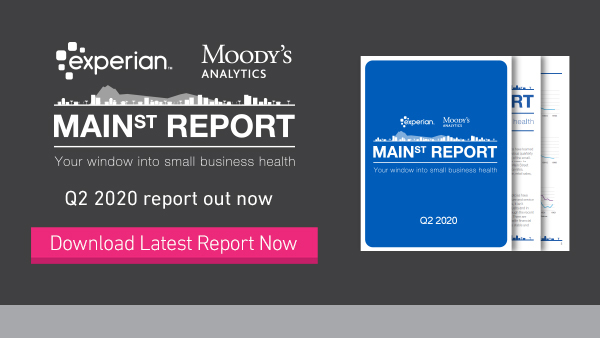
Experian and Moody's Analytics have just released the Q2 2020 Main Street Report. The report brings deep insight into the overall financial well-being of the small-business landscape, as well as offer commentary on business credit trends, and what they mean for lenders and small-businesses. Small businesses have turned to borrowing to survive periods of prolonged slumping sales, in many cases from government programs offering loan forgiveness. This increased borrowing has masked rising delinquent balances, but such a solution is a short-term fix. To keep their credit current, small businesses will need to find ways to generate revenue. Defaults are expected to rise in coming quarters as forbearance programs expire and as customers are likely to change their priorities in the wake of COVID-19. In Q2, moderate delinquency, defined as 31-90 days past due, rose to 1.66 percent from 1.61 percent, marking the fourth consecutive quarter of increasing delinquency, and the first year-over-year increase since this time last year. The closure of many state and local economies in April and the first half of May left many businesses facing severe revenue shortfalls in the second quarter. This environment has resulted in businesses listing poor sales as the second most important problem facing small businesses, according to the NFIB. If you would like to get the full analysis of the data behind the latest Main Street Report, presented by leading economists from Moody's Analytics and Experian, watch the Quarterly Business Credit Review webinar.

As business delinquencies rise in response to COVID-19, credit departments are becoming increasingly challenged. In our August 13th Sip and Solve webinar, John Krickus and Andrew Moore will be on hand to share some strategies for maximizing receivables amid rising delinquencies. Managing receivables has never been more important or more challenging. Traditional approaches may no longer apply. In this 15-minute Sip and Solve session, we discuss some solutions for effectively and efficiently handling the increase in receivables many companies are facing. After watching this talk you will learn three key takeaways: Prioritizing receivable management in today's environment Analytic tools for managing receivables Flexing receivables strategies to meet your company's priorities Click to view full slides and transcripts from this session.
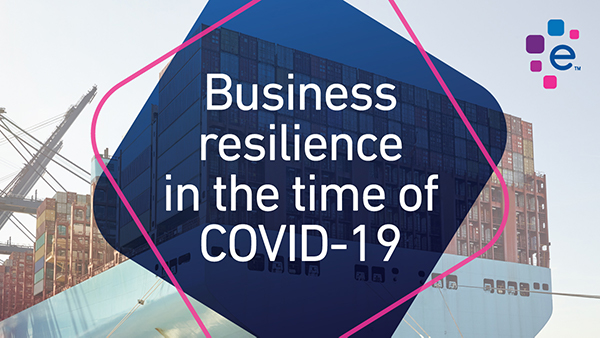
In a favorable economic climate, business resilience is often treated as an afterthought. Success is measured in rapid growth and leaps of progress, while failure is little more than a tempering of that expansion. It’s only when things slow down - like during a global pandemic - that companies are forced to take stock of the ground they stand on. As the economy slows to a crawl and entire industries feel the squeeze, business resilience will determine which organizations make it through to the other side. Whether you’re on the supply side or the demand side, chances are your organization is being tested right now. Here are some practical strategies to stay resilient in the time of Covid-19. Gerard Smith, President of Global Risk Management Solutions (GRMS), works with companies who are either on-boarding new suppliers or evaluating current suppliers. When the Covid-19 pandemic disrupted supply chains in most industries, many of these companies started scrambling to find replacement suppliers. Finding a reliable supplier is always a challenge, but it’s even more difficult during a global pandemic and economic crisis. The best practice here is still to vet new suppliers carefully. Smith’s company creates a risk assessment program for Experian clients that analyzes 50 different financial and legal components, including the following: If they’re on the OFAC sanctions list If they’re financially stable If they actually have the certifications they claim to have If they have insurance If they’ve received negative press Many companies fail to do their due diligence when it comes to suppliers, especially if they’re trying to fulfill orders quickly. More often than not, this leads to bigger problems down the line. If you hire a supplier that’s hemorrhaging money, for instance, they may file for bankruptcy right after you pay them for a major shipment. Companies that use GRMS will be notified regularly if a supplier’s financial or legal status changes. If a supplier cancels their insurance coverage, for example, that could indicate financial struggles. Staying abreast of information like this allows businesses to be proactive with suppliers and avoid being blindsided. Make Sure Clients Are Financially Healthy On the flip side of the buyer-supplier relationship, suppliers are now being asked to extend due dates. Deciding how to comply with these requests can be tricky. Most want to be understanding and reasonable, but there is often legitimate concern over whether they’ll receive payment. Brodie Oldham, Senior Director of Analytic Consultancy for Experian, said Experian offers several services for suppliers who need to gauge how reliable their customers are in this moment. Experian has a special Covid-19 risk index that suppliers can overlay on top of existing credit models. This tool can help determine whether or not a client is in an unstable financial position. If the company operates in a highly impacted part of the country or industry, the supplier can use that information to change the terms. For example, they can sell fewer items to minimize the risk of an unpaid invoice. Experian also monitors credit utilization for business credit cards and other lines of credit. If a company’s credit utilization surpasses a certain threshold, they can alert the supplier who can halt future shipments until the utilization decreases. Find Faster Ways to Evaluate Creditworthiness Many suppliers depend on a company’s credit information to determine its reliability as a buyer. Likewise, credit bureaus are being forced to reevaluate their models in response to the changing business landscape brought on by Covid-19. Enter the agile credit function. The term agile has traditionally been used in the context of software development to describe an iterative approach where requirements and solutions evolve through collaboration between cross-functional teams. It allows companies to adapt to new requests quickly and improve time-to-market. Agile is all about being nimble and responsive - something credit bureaus are prioritizing in today’s uncertain economy. Agile credit means finding new, faster ways of evaluating customers and determining their ability to pay, in a time when that information can change daily. “When everything shut down in March, credit people got thrown for a loop,” said Dan Meder, Vice President of Consulting, Product Marketing and Alliances for Experian Business Information Services. “They needed a way to manage that change very quickly.” That’s where having an agile credit approach comes in. “It’s about using agile principles in your credit function to respond more quickly to changing market needs,” Meder said. Using an agile credit system helps suppliers decide what kind of terms to offer their customers. Many companies are asking suppliers to extend their terms and due dates, often switching from net-30 to net-60. Suppliers then have to decide if they can trust these companies to repay them within that longer time frame, Meder said. If companies in this position use an agile credit function, they can be more responsive and confident in the terms they set out because they’re basing their credit policies on the current state of their customer environment. This requires operating with the latest possible information on how current economic conditions are affecting their customers. Meder said that making credit function more agile requires direction from the head of the credit department and other members of that department. They can also utilize software programmers if the automatic process needs to be updated or any outside consultants for specific analytical expertise. “The idea is to bring together a team of people with direct involvement in managing the credit function to assess how best to manage the customer experience given the current state of the customer environment,” he said. “This includes setting policies around risk assessment as well as credit terms and collection processes.” Meder said companies should have technology that allows them to tinker with their credit function so they can make changes quickly. “This is especially true in a fast-changing or uncertain environment such as what we are seeing with COVID-19 and the uncertain effect it is having on our economy’s future,” he said. “In fact, it is turbulent times such as these where being “agile” is most important since the credit department needs to be able to alter course quickly if the customer environment changes for better or for worse.” Consider Being Flexible With Clients While delayed payments from clients is upsetting, avoid taking your current client relationships for granted. While a more stringent approach from suppliers is understandable right now, Meder cautions companies to remember that the pandemic will end at some point. At that time, companies will remember which suppliers were flexible about payments, due dates and terms - and which companies weren’t. “If you weren’t good to them while they were struggling, they’re going to forget about you when things turn around,” Meder said. To find out how fine-tuning your company’s credit function can help it weather the current economic crisis, reach out to your Experian representative.

This year, Experian business information services released some major enhancements to our BusinessIQ product. The project was completed by a highly skilled team here at Experian and heavily driven by customer feedback. Today we'll speak with Casey Hald. one of our lead software developers as he takes us through some of the enhancements to BusinessIQ. The transcription of our interview with Casey has been lightly edited to improve readability. What was the main goal of this redesign on BusinessIQ? CH: The goal of the redesign project was to not only improve BIQ user experience and design but also update the overall framework as well. We wanted to bring BIQ into 2020 strong and I feel like we did that. Maybe you could talk a little bit about how that process worked in this case. CH: So first I dug up the existing research material when BIQ was first being developed and used that as sort of a baseline for what BusinessIQ is all about. Since coming into Experian, I was brand new to the credit space. So having that research material was very important to me to have empathy for our users. So, I was lucky that in the first month of joining the team I traveling across the U.S. visiting our biggest clients, well both big and small and mom and pop companies and basically discovering why they use BIQ and you know, why it was important to them. So, they sent you out on the road to meet face to face. It wasn't just a conference calls? CH: Yeah, face to face. So we went from the West Coast to the Midwest, to the East coast and we visited companies, big and small. It was a treat. It was over 27 different participants across 16 different companies. So we got to talk to a lot of people. What were their struggles with BusinessIQ? CH: Yeah, so they love BusinessIQ for the speed and accuracy of pulling credit reports. They choose us over our competitors because of that speed. So we wanted to make sure that with this redesign that wasn't compromised at all. And that was something that they love with the existing design. However, with the existing design, unless you are already privy to how BusinessIQ is structured, a new credit analyst coming into this pace could be somewhat confused. So we used that as sort of a baseline to decide how we wanted the redesign to go. CH: So the first thing we did was we simplified the forgot password workflow. A lot of the challenges that our customers ran into was updating their credentials, managing their credentials. With BusinessIQ, it's security first. So we require that they log in. They can't just log in and walk away, the system will just be open for people to compromise security. It refreshes every 15, 20 minutes, so sometimes they forget to log in. So we wanted to simplify that workflow by adding a remember me functionality. So that way they can plug in their credentials and can log in. We also modified the look and feel and the design to a more modern look and feel. And so that would involve what the site navigation? CH: Yeah, the sign navigation. With that we updated the layout, moving it to the side to more of a modern dashboard, which you see a lot of times with modern applications. They have navigation right here and then the content takes up the majority of the space, which is something that we wanted. We removed search from the navigation since, it's now in the header searches, the meat, and potatoes of BusinessIQ. What our customers use and love is search. So we wanted to take that out of the body, and give that its own container and put that right above the navigation. So it's something that becomes the focal point of the application. We also reordered the search elements based on the order of importance based on customer feedback. So it's not just alphanumeric. We reordered it based on the importance of what we learned from our users. What about pulling reports? Because I mean, our customers love to pull reports and they pull a lot of them, right? CH: Absolutely. So, when they pull the reports, it's arguably the most important workflow to BusinessIQ. They use BusinessIQ to view a credit report. So if a customer wanted to pull a new report in the old design, they would need to first search a company, view an old report, click on pull report, and then view the report configuration options, which aren't exactly super organized, and then click to view the report. So with the new design, the user searches a company views the company information alongside the report configuration options and then clicks on the report. So we've lessened the number of clicks by one or two and organized it to a step by step process. So a new credit analyst coming into space doesn't get confused about what configurations he or she needs to make. The old design requires potentially 26 form inputs while the new design contains only six. Our goal made pulling a report easier by making the configuration options into a series of steps, as opposed to just a random configuration. What are the other big improvements? Did you do anything in credit configuration? CH: Yeah. So 85% of our users stated that they never changed the report type because they simply didn't understand what each report type contained. They didn't understand the benefits of a Premiere Profile versus a business report. So we added a summary for each report type. So any new credit analysts that come in, they can simply read the summary and understand what each report type means to them, and why they need to pull it. Since users often pull the same report, we added a separate card for past pulled reports. So it uses a one-two, three-step approach, making it super easy for a new user to use. And there's only one call out with all the options already default selected. So there are a lot fewer form inputs. So this has got to be saving our customers a ton of time. Right? It's all about productivity and making your business more efficient. Is that really how those improvements have been received? CH: Totally, and a lot of our credit analysts, when they use BusinessIQ, they're in and out in five minutes. They go in, search a company, pull a report, log out, get on with the rest of their workday. So we wanted to keep that, you know, save their time because time is the most important asset you have right? So we wanted to make sure that that was first and foremost. What about the management of reports if they're pulling a lot of reports, is the management of that been fixed or improved? CH: Absolutely. So we added a quick search filter to find exactly the report you're looking for. For a new credit analyst, we rolled up all the filters into a simple selector delimited by date. So they always see the freshest report at the top, which is super important. The user now has control over how many reports that they can view at once with our new paginated system, which is utilizing Google materials design documentation. So we took kind of what they learned, through their research and utilize that into our cards and components as well. The business name is now the focal point instead of the date, which is super important. And we removed the reference code as it wasn't being used among users. It was a big sequence of numbers that kind of got in the way. And one of the goals of our redesign is to cut away the things that our users don't use and create focal points for the things that were most important to them. So that's how we improved managing reports. What has the response from our clients been? CH: luckily for me and my job, they love it. they love the new visual direction. They say that it's pretty, which is a compliment. But they also say that it is much easier for them to use. One of the things that we improved, in terms of cutting things away was that the old dashboard contained 10 to 15 different cards with newsreels tasks, some charts, portfolio charts, things that our customers didn't necessarily use first and foremost on the dashboard. They kind of just went straight to search. And when I asked them if you had a Wishlist on what you would like to see on the dashboard, what would it be? And the first thing that they said was recent reports. If you could put recent reports at the top, so that way I can always see the last report that I pulled. So I don't make a mistake of pulling that same report. That would be lovely. So, that was one of the major things that we did. And we're seeing a lot of positive feedback, from just that simple improvement alone, let alone the other improvements that we've made. So, the reports have been positive and we're continuing to keep our ears open. We have a lot of empathy for our users and the way that they use BusinessIQ. So we're going to continue to listen to them and, and continue to iterate on the design since the design is a very fluid solution, right? Design changes over time. So we're keeping that first and foremost for our users. What was your biggest learning? CH: So the thing that I learned the most was how quickly our customers use the application. They go in, they search, find what they're looking for, they use it as a confirmation of address and phone number. For our credit analysts, the phone number is super important alongside address information when they're pulling a credit report. Since a lot of companies have ambiguous locations that could look like one another. So I learned that differentiating those elements was super important to them. It actually sped up their workflow. So we use that in conjunction with some of the other design decisions that we made to improve the overall user experience. So for me, being in the credit space and having the opportunity to redesign the experience I really learned from our users, that has been a privilege.
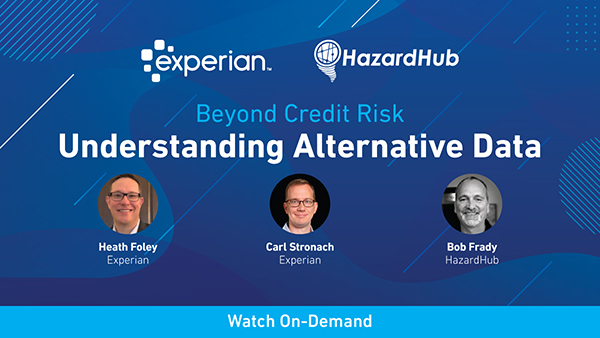
When insurance underwriters make mistakes, bad policies can cost billions. Alternative forms of data is helping change those outcomes, particularly for insurance providers in helping them identify blind spots and accurately underwrite policies. Watch our special Insurance-focused webinar titled "Beyond Credit Risk - Understanding Alternative Data" with HazardHub. Heath Foley and Carl Stronach from Experian is joined by Bob Frady from HazardHub during this lively discussion. Alternative sources of data are growing in importance in the market. The key to our data platform is constantly investing and sourcing a wider variety of data such as geographic hazards, social media, and OSHA data in order to represent a fuller picture of the health of the business. In this one hour talk, we walk through: Utilizing property-level hazard risk assessments The growing importance of alternative sources of data How to bring superior data to power comprehensive insights Related information What is alternative and non-traditional data/
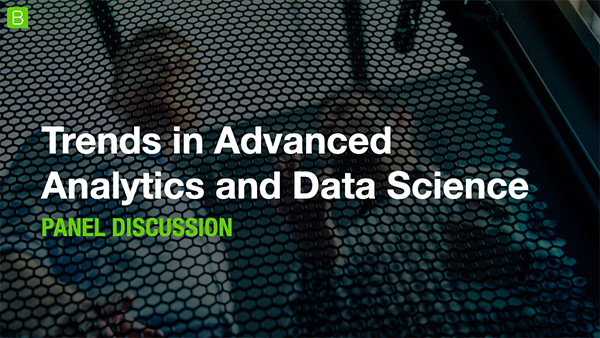
Matt Shubert, Experian's Director of Data Science and Modeling participated in a discussion about trends in AI and Machine Learning. He shared insights on how Experian Business Information Services is leveraging these technologies for clients. Matt and a panel of industry experts discuss how businesses are taking advantage of predictive analytics technology to gain a competitive edge in the marketplace. Webinar Highlights: - Use cases that show how AI and machine learning are helping companies be more proactive than ever - How predictive modeling can lead to more informed business decisions - What steps organizations can take to adopt an AI-enhanced analytics strategy that works for them - And more! Panelists: Puravee Bhattacharya, Senior Data Scientist and Analytics, BI & Performance Reporting at Energia Nirupam Srivastava, Vice President - Strategy and AI at Hero Enterprise Matt Shubert, Director of Data Science and Modeling at Experian
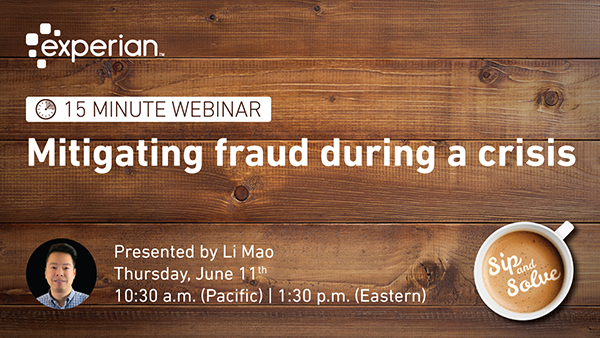
In 2019, 3 in 5 businesses noticed an increase in fraud over a 12-month period. Today, in the face of COVID-19 and the economic downturn, it’s safe to assume that these numbers have increased. In this Sip and Solve session, Experian's commercial fraud expert, Li Mao, discusses the process of introducing friction into credit processes to discourage fraudsters. He'll also talk about: The most common types of fraud you can expect during COVID-19 What first party fraud is and how you can detect it Tips on how you can combat first party fraud and more WATCH RECORDING

